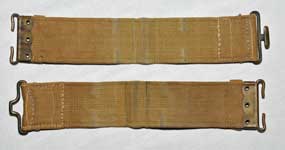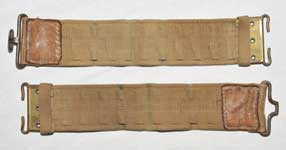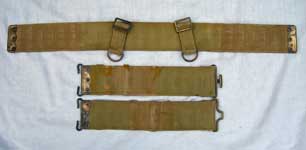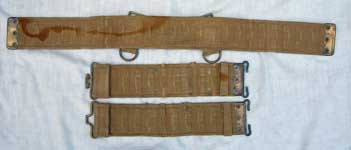| Karkee Web Home Page | Officer's Main Page | W.E.O. Main Page | W.E.O. Experimental Main Page |
Web Equipment, Officers, Experimental
Waist Belts

 Mills patented “back-adjustment equipment” had been established first with Pattern 1913 W.E., but that pattern had used the method simply to connect a pair of Cartridge carriers, each of which carried one half of a belt buckle. For officers, Pieces, side, were created, to make the Strap, back adjustment, into a full belt. The material used was “flat-loop belting”, which was passed through each half of the belt buckle. This was of the distinctive U.S. “loop and olivet” form, being more a formed wire product, than the later blanked-out U.K. designed “hook and loop” buckle of the 1919 buckle. The cut ends were doubled under twice and stitched into place, which gave quite a thick junction on the inside of the belt. The example illustrated here has had a user-mod, with leather patches stitched over the junction, seemingly for protection against wear on the uniform. From the Paul Hannon Collection, photographs © Paul Hannon 2010.
Mills patented “back-adjustment equipment” had been established first with Pattern 1913 W.E., but that pattern had used the method simply to connect a pair of Cartridge carriers, each of which carried one half of a belt buckle. For officers, Pieces, side, were created, to make the Strap, back adjustment, into a full belt. The material used was “flat-loop belting”, which was passed through each half of the belt buckle. This was of the distinctive U.S. “loop and olivet” form, being more a formed wire product, than the later blanked-out U.K. designed “hook and loop” buckle of the 1919 buckle. The cut ends were doubled under twice and stitched into place, which gave quite a thick junction on the inside of the belt. The example illustrated here has had a user-mod, with leather patches stitched over the junction, seemingly for protection against wear on the uniform. From the Paul Hannon Collection, photographs © Paul Hannon 2010.

 The Strap, back adjustment carried two angled 1-inch buckles on web chapes for the rear Brace ends, with brass loops at the opposing ends of these chapes. The Brace attachments had fixed loops on the lower extremities of their gateslide buckles. The resulting four brass loops, at the lower edge of the belt, provided attachment points for the “dog clips” on Haversacks and Water bottle carriers, both of various designs, that were originally designed for attachment to a Sam Browne Belt. The combination of brass loops and Brace ends were intended as an “either/or” facility, rather than “and/and”, although a commercial map case, usually with dog clips, might usefully have been added to the loops as well. From the Paul Hannon Collection, photographs © Paul Hannon 2010.
The Strap, back adjustment carried two angled 1-inch buckles on web chapes for the rear Brace ends, with brass loops at the opposing ends of these chapes. The Brace attachments had fixed loops on the lower extremities of their gateslide buckles. The resulting four brass loops, at the lower edge of the belt, provided attachment points for the “dog clips” on Haversacks and Water bottle carriers, both of various designs, that were originally designed for attachment to a Sam Browne Belt. The combination of brass loops and Brace ends were intended as an “either/or” facility, rather than “and/and”, although a commercial map case, usually with dog clips, might usefully have been added to the loops as well. From the Paul Hannon Collection, photographs © Paul Hannon 2010.

 This second example is the usual form and comes from the Nick Wall Collection, photographs © Nick Wall 2009. The rear ends of the side pieces had Tips, brass, 2.25-in., with hooks riveted in place, with adjacent thin web loops, to tidy away the running ends of the back adjustment strap. This resulted in the Tips remaining visible on the outside face of the Belt. Mills did not address this “naked” look until post-war.
This second example is the usual form and comes from the Nick Wall Collection, photographs © Nick Wall 2009. The rear ends of the side pieces had Tips, brass, 2.25-in., with hooks riveted in place, with adjacent thin web loops, to tidy away the running ends of the back adjustment strap. This resulted in the Tips remaining visible on the outside face of the Belt. Mills did not address this “naked” look until post-war.
© R.J. Dennis February 2009